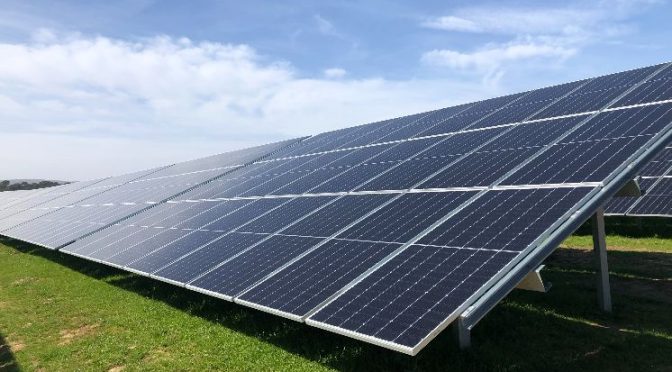In recent years, photovolyaic energy has emerged as a viable and sustainable solution to the world’s energy needs. With growing concerns about environmental sustainability and the search for renewable energy sources, many people have questions about how solar energy works and what its benefits are. With that in mind, let’s answer the five most frequently asked questions about solar energy.
- When the electricity runs out, does solar power work?
This is one of the most common questions about how photovoltaics works and the answer is: Yes, solar energy continues to work even when there is an interruption in the traditional electrical grid. This is because photovoltaic power systems are usually equipped with storage batteries that can store excess energy produced during the day for use at night or in the event of a grid power outage.
When grid power is available, solar systems typically use electricity produced by solar panels in real time. However, when a power outage occurs, the system can automatically switch to the energy stored in the batteries, ensuring continuous power supply for consumers.
This ability to operate independently of the grid makes solar energy an attractive option for homes, businesses and communities seeking energy security and resilience to grid outages.
- How much energy does a solar panel generate per day?
This is another very common question when it comes to solar energy. The amount of energy generated by a solar panel or photovoltaic panel per day depends on several factors, including the geographic location, the tilt and orientation of the solar panel, weather conditions, and the efficiency of the system. It is important to differentiate between solar panels and photovoltaic panels:
Solar panel: This term is often used generically to refer to the individual components that make up a solar system, including solar cells and semiconductor materials that convert sunlight into electricity.
Photovoltaic Panel: Refers to the set of interconnected solar panels that form a single solar energy generation unit. A photovoltaic panel can be made up of several solar panels.
On average, a high-quality solar panel can generate between 250 and 400 watts of electricity per hour of direct sunlight. Considering a typical sunny day, a solar panel can produce about 2 to 4 kWh (kilowatt hours) of electricity per day. However, this estimate can vary significantly depending on the factors mentioned above.
- Is it possible to generate solar energy at night?
This may seem like a question with an obvious answer about solar energy, however, there are still interesting facts on the topic. Although solar energy is an abundant and renewable source during the day, it is not possible to generate energy directly from sunlight at night. This is because solar panels rely on sunlight to produce electricity.
However, as mentioned above, many solar energy systems are equipped with storage batteries that can store excess energy produced during the day for later use, even at night. During the day, solar panels charge batteries, which can then power electrical devices when sunlight is not available.
Additionally, in some regions, solar energy systems can be supplemented with other renewable energy sources, such as wind turbines or hydroelectric systems, to provide power during periods of low solar production.
- What is the cost of solar energy?
The cost of a solar energy system varies depending on several factors, including the size of the system, the quality of the equipment, the complexity of the installation, available tax incentives, and market conditions.
In recent years, the cost of solar panels and photovoltaic systems has decreased significantly due to advances in technology and production scale. Additionally, government policies to encourage renewable energy, such as subsidies, tax credits, and power purchase rates (net metering), have helped make solar energy more accessible to consumers.
Currently, the average installation cost of a residential solar energy system varies between €2,000 and €6,000 per kilowatt (kW) of installed power. However, it is important to highlight that this value can be recovered over time through savings on the electricity bill and the environmental benefits that solar energy provides.
- What are the environmental impacts of solar energy?
Although solar energy is widely considered a clean and sustainable energy source, its implementation and operation can still have some environmental impacts and this ends up raising some questions. However, these impacts are generally considered minor compared to those associated with non-renewable energy sources such as fossil fuels.
Some of the environmental impacts of solar energy include:
Land Use: Installing large solar panel arrays may require the use of large areas of land, especially on utility-scale projects. This can have effects on local habitats and biodiversity, although in many cases the land beneath the panels can be used for other purposes, such as agriculture.
Water consumption: Some solar energy systems, especially those using concentrating solar technology, may require water for cooling. Water consumption may be a concern in regions where water is scarce or where there is already competition for water resources.
Waste production: Although solar panels are generally durable and have a long lifespan, they will eventually need to be replaced. Improper disposal of used solar panels can lead to waste generation and soil and water pollution. However, many manufacturers are developing recycling programs to minimize these impacts.
Despite these potential impacts, solar energy remains one of the cleanest and most environmentally friendly options for generating electricity, contributing to the reduction of greenhouse gas emissions and the mitigation of climate change.
In summary, as we saw in the answers to these questions, solar energy offers a renewable and sustainable energy source that can provide clean, reliable electricity for a variety of applications. By better understanding how solar energy works and its benefits, we can harness its enormous potential to help drive a global transition to a greener, more sustainable energy future.


